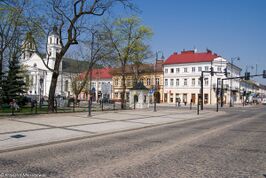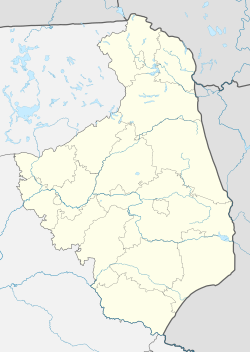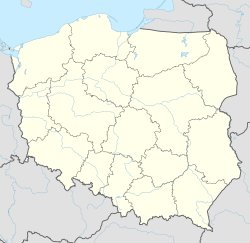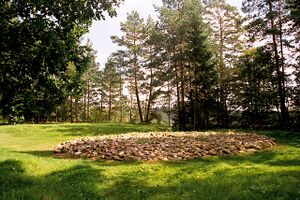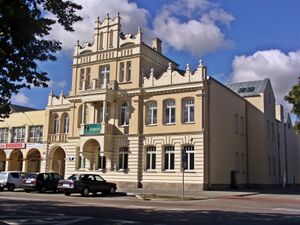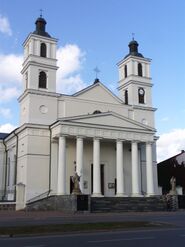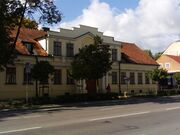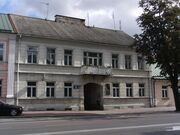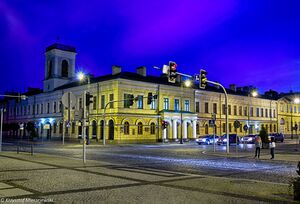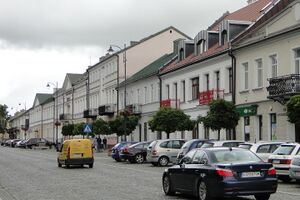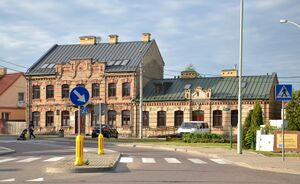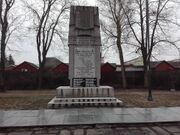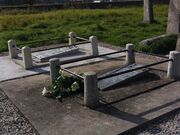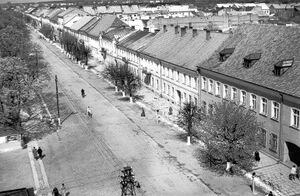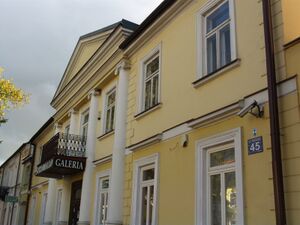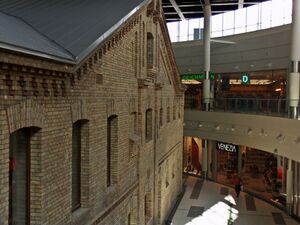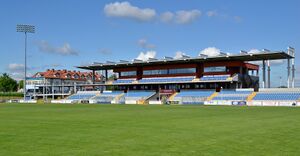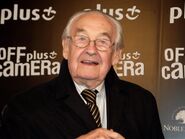سوڤاوكي
سوڤاوكي
Suwałki | |
|---|---|
| |
| الإحداثيات: 54°05′56″N 22°55′43″E / 54.09889°N 22.92861°E | |
| البلد | بولندا |
| الڤويڤودية | پودلاسكي |
| المقاطعة | مقاطعة المدينة |
| التأسيس | 1690 |
| حقوق المدينة | 1720 |
| الحكومة | |
| • الرئيس | Czesław Renkiewicz |
| المساحة | |
| • الإجمالي | 65٫24 كم² (25٫19 ميل²) |
| المنسوب | 170 m (560 ft) |
| التعداد (2010) | |
| • الإجمالي | 69٬690 |
| • الكثافة | 1٬100/km2 (2٬800/sq mi) |
| منطقة التوقيت | UTC+1 (ت.و.أ.) |
| • الصيف (التوقيت الصيفي) | UTC+2 (ت.و.أ.ص.) |
| Postal code | 16-400 to 16-403 |
| مفتاح الهاتف | +48 87 |
| لوحات السيارات | BS |
| الموقع الإلكتروني | um.suwalki.pl |
سوڤاوكي ( Suwałki ؛ [suˈvau̯kʲi] (![]() استمع)؛ (لتوانية: Suvalkai؛ باليديشية: סואוואַלק؛ إنگليزية: Suwałki)، هي مدينة في شمال شرق پولندا عام 2011 كان عدد سكانها 69.210 نسمة. وهي عاصمة مقاطعة سوڤاوكي ومن أهم المراكز التجارية في ڤويڤودية پودلاسكاي.[1] سوڤاوكي هي أكبر مدينة والعاصمة التاريجية لمنطقة سوڤاوكي حتى عام 999 وكانت عاصمة ڤويڤودية سوڤاوكي. تبعد سوڤاوكي 30 كم تقريباً عن الحدود اللتوانية الجنوبية الغربية وتحمل اسمها منطقة محمية الپولندية المعروفة باسم منتزه سوڤاوكي الطبيعي. يتدفق نهر تشارنا عبر المدينة.
استمع)؛ (لتوانية: Suvalkai؛ باليديشية: סואוואַלק؛ إنگليزية: Suwałki)، هي مدينة في شمال شرق پولندا عام 2011 كان عدد سكانها 69.210 نسمة. وهي عاصمة مقاطعة سوڤاوكي ومن أهم المراكز التجارية في ڤويڤودية پودلاسكاي.[1] سوڤاوكي هي أكبر مدينة والعاصمة التاريجية لمنطقة سوڤاوكي حتى عام 999 وكانت عاصمة ڤويڤودية سوڤاوكي. تبعد سوڤاوكي 30 كم تقريباً عن الحدود اللتوانية الجنوبية الغربية وتحمل اسمها منطقة محمية الپولندية المعروفة باسم منتزه سوڤاوكي الطبيعي. يتدفق نهر تشارنا عبر المدينة.
التسمية
اسم سوڤاوكي مشتق من اللتوانية su- (قريب) وvalka (الجدول، المستنقعات)، ويعني "المكان القريب من النهر الصغير أو منطقة المستنقعات".[2]
التاريخ
The area of Suwałki had been populated by local Yotvingian and Prussian tribes since the early Middle Ages. However, with the arrival of the Teutonic Order to Yotvingia, their lands were conquered and remained largely depopulated in the following centuries.[بحاجة لمصدر]
القرن 17
The village was founded by Camaldolese monks, who in 1667 were granted the area surrounding the future town by the Grand Duke of Lithuania and the King of Poland John II Casimir. Soon afterwards the monastic order built its headquarters in Wigry, where a monastery and a church were built.[بحاجة لمصدر]
The new owners of the area started rapid economic exploitation and development of the forests; they brought[بحاجة لمصدر] enough settlers (mainly[بحاجة لمصدر] from overpopulated Masovia) to build several new villages in the area. Also, production of wood, lumber, tar and iron ore was started. The village was first mentioned in 1688; two years later it was reported to have just two houses.[بحاجة لمصدر]
القرن 18
However, the growth of the village was fast and by 1700 it was split into Lesser and Greater Suwałki. The village was located almost exactly in the center of Camaldolese estates and lay on the main trade route linking Grodno and Merkinė with Königsberg.[بحاجة لمصدر]
In 1710 King Augustus II the Strong granted the village a privilege to organize fairs and markets. Five years later, in 1715, the village was granted town rights by the grand master of the order, Ildefons. The town was divided into 300 lots for future houses and its inhabitants were granted civil rights and exempted from taxes for seven years. In addition, the town was granted 18.03 km2 (6.96 sq mi) of forest that was to be turned into arable land. On May 2, 1720, the town rights were approved by King August II, and the town was allowed to organize one fair a week and four markets a year. In addition, a coat of arms was approved, depicting Saint Roch and Saint Romuald.[بحاجة لمصدر]
After the Partitions of Poland in 1795, the area was annexed by Prussia. In 1796 the monastery in Wigry was dissolved and its property confiscated by the Prussian government. The following year a seat of local powiat authorities was moved to the town, as well as a military garrison. By the end of the 18th century, Suwałki had 1,184 inhabitants and 216 houses. A large part of the population was Jewish.[بحاجة لمصدر]
القرن 19
In 1807 Suwałki became a salient of the newly formed Duchy of Warsaw and one of the centres of the department of Łomża. After the defeat of Napoleon Bonaparte and the Congress of Vienna, the area was incorporated into the Congress Poland ("Russian Poland"), as a part of the Russian Empire (Russian partition). The status of a powiat capital was briefly withdrawn, but it was reintroduced on January 16, 1816, when the Augustów Voivodeship was created and its government was gradually moved to Suwałki. Soon afterwards the older town hall was demolished and replaced with a new one, and General Józef Zajączek financed the paving of most of the town's streets. The cemetery was moved to the outskirts from the town centre, and that area became a town park. Also, the Russian authorities built the Saint Petersburg–Warsaw Railway, which added to the town's prosperity.[بحاجة لمصدر]
In 1820 a new church was built. In 1821 the first synagogue was opened. In 1829 a permanent post office was opened in Suwałki. Between 1806 and 1827 the town's population almost tripled and reached 3,753 people living in 357 houses. During the November Uprising of 1831, the town's population took part in the struggles against Russia, but the town was pacified by the Russian army on February 11, 1830. In 1835 the government of Tsar Nicholas I decided not to move the capital of the voivodeship to Augustów. Two years later the Voivodeships of Poland were re-designated as gubernias, and the town became the capital of the Augustów Gubernia.[بحاجة لمصدر]
In 1826 the Russians passed an investment plan and authorities initiated the construction of new public buildings. In 1835 a police station was built, in 1844 a new town hall and Orthodox and Protestant churches were completed. Soon afterwards a new marketplace was opened, as well as St. Peter's and Paul's hospital and a gymnasium. In addition, between 1840 and 1849 the main Catholic church was refurbished by many of Poland's most notable architects of the era, including Piotr Aigner, Antonio Corazzi and Enrico Marconi. To change the town's architecture and break with its rural past, in 1847 the town council passed a decree banning the construction of new wooden houses.[بحاجة لمصدر]
The town's population continued to grow rapidly. In 1857 it had 11,273 inhabitants and in 1872 almost 20,000. Newly built factories needed workers and these were brought from workers recruited widely in Europe. The mixed Polish-Jewish-Lithuanian population was soon joined by people of almost all denominations that worshipped in the Russian Empire.[بحاجة لمصدر]
Soon Suwałki became the fourth-most populous town in Congress Poland. After the January Uprising of 1863, administration reform was passed to unify the Polish lands with Russia completely. In 1866 the gubernia of Augustów was renamed to Suwałki Gubernia. However, the route of the newly built Saint Petersburg-Warsaw railway bypassed Suwałki, adversely affecting its prosperity. It was not until the early 20th century that the establishment of a new Russian army garrison revived the economy. Also, a railway line linking Suwałki with Grodno was finally completed.[بحاجة لمصدر]
القرن 20-الحاضر
After the spring of 1905, when the Russians were forced to accept a limited liberalization, the period of Polish cultural revival started. Although the Polish language was still banned from official use, new Polish schools were opened, as well as a Polish-language Tygodnik Suwalski weekly and a library. After World War I broke out, heavy fights for the area erupted. Finally in 1915, the Germans broke the Russian front and Suwałki was under German occupation. The town and surrounding areas were detached from the rest of the Polish lands and were directly administered by the German military commander of the Ober-Ost Army. Severe laws imposed by the German military command and the tragic economic situation of the civilians led to the creation of various secret social organisations. Finally, in 1917, local branches of the Polska Organizacja Wojskowa were created.[بحاجة لمصدر]
After the collapse of the Central Powers in November 1918, the local commander of the Ober-Ost signed an agreement with the Temporary Council of the Suwałki Region and de facto allowed for the region to be incorporated into Poland. However, the German army remained in the area and continued its economic exploitation. In February 1919 the local inhabitants took part in the first free elections to the Polish Sejm, but soon afterwards the German commanders changed their mind. They expelled the Polish military units from the area and in May passed the territory to Lithuanian authority.[بحاجة لمصدر]
پولندا المستقلة
By the end of July 1919, the Paris Peace Conference granted the town to Poland. As the newly-established border was disapproved of by the Polish government, it organised the Sejny Uprising on August 23, 1919. The Polish-Lithuanian War erupted and for several days fighting for control over Suwałki, Sejny and other towns in the area took place. The war ended on the insistence of the Entente in mid-September.[بحاجة لمصدر] Negotiations took place in Suwałki in early October. During the Polish-Bolshevik War, the town was captured by the Communists and, after the Battle of Warsaw, it was again passed to the Lithuanians. It was retaken by the Polish Army.[بحاجة لمصدر]
In the inter-war period, Suwałki became an autonomous town within the Białystok Voivodeship (1919-1939). This resulted in another period of prosperity, with the town's population rising from 16,780 in 1921 to almost 25,000 in 1935.[بحاجة لمصدر] The main source of income shifted from agriculture to trade and commerce. Also, in 1931 the new water works and a power plant were built. Also, Suwałki continued to serve as one of the biggest garrisons in Poland, with two regiments of the Polish 29th Infantry Division and almost an entire Suwałki Cavalry Brigade stationed there. Beginning in 1928, Suwałki was established as the headquarters of one of the battalions of the Border Defence Corps.[بحاجة لمصدر]
الحرب العالمية الثانية
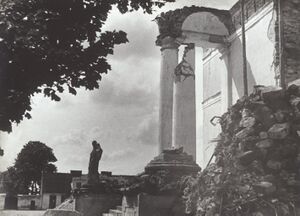
During the later stages of the Polish Defensive War of 1939, the town was briefly captured by the Red Army. However, on October 12 of the same year, the Soviets withdrew and transferred the area to the Germans, in accordance with the Molotov–Ribbentrop Pact.[بحاجة لمصدر] The city was renamed Sudauen and annexed directly into Nazi Germany's province of East Prussia. Germans carried out mass arrests of Poles as part of Intelligenzaktion in the fall of 1939 and spring of 1940.[3] Arrested Poles were deported to a transit camp in Działdowo or murdered on the spot.[4] Nazi German severe laws and terrorism led to the creation of several resistance organisations in response. Although most initially destroyed by the Gestapo, by 1942 the area had one of the strongest ZWZ and AK networks. In the Szwajcaria district there are mass graves of members of the Polish resistance movement murdered by the Germans on April 26, 1940 and April 1, 1944.[بحاجة لمصدر]
Despite the resistance, almost all of the town's once 7,000-strong Jewish community was deported and murdered, beginning in December 1939, when German troops brought the elderly, sick, and disabled into a nearby forest and machine-gunned them en masse. The Germans, with help from local collaborators, deported the community's surviving Jews to ghettos in other towns. Nearly all either perished there or were murdered in Nazi concentration camps. The occupying Germans also systematically destroyed all traces of Jewish history and culture in the town, demolishing synagogues and desecrating Suwałki's Jewish cemetery, where a memorial and wall of gravestone fragments stand today.[بحاجة لمصدر] Also, in Suwałki's suburb of Krzywólka, the Germans established a POW camp for almost 120,000 Soviet prisoners of war.[بحاجة لمصدر]
On October 23, 1944, the town was captured by the forces of the Soviet 3rd Belarusian Front. The fights for the town and its environs lasted for several days and took the lives of almost 5,000 Soviet soldiers before they defeated the Germans. The anti-Soviet resistance of former Armia Krajowa members lasted in the forests surrounding the town until the early 1950s.[بحاجة لمصدر]
Suwałki did not suffer much damage during World War II, most of the historic buildings survived the war, and the damage to the city was estimated at only 5-10%, which was quickly rebuilt.[بحاجة لمصدر]
جمهورية پولندا الشعبية
The apparatus subordinate to the Polish Committee of National Liberation took power in Suwałki without major problems.[بحاجة لمصدر] Immediately after the city's liberation by units of the Red Army, on October 23, 1944, Stanisław Łapot, a member of the former Communist Party of Poland, one of the organizers of the Polish Workers' Party in Bialystok, came from Sejny to Suwałki. He was accompanied by several officials previously organized in Sejny with the deputy head Edmund Przybylski, as well as Tadeusz Sobolewski - the president of the interim Poviat Council.[بحاجة لمصدر] On the same day, at Mickiewicz Square, supposedly spontaneously organized, so with the participation of new authorities and over five thousand inhabitants of the city, and then in the "Rusałka" cinema hall a meeting of representatives of the population with the envoys of the Polish Committee of National Rebirth.[بحاجة لمصدر] Actions aimed at organizing the Suwałki authorities were taken shortly after the liberation. The Starosta handed over the power in the city to the temporary mayor Tadeusz Sobolewski on October 24, 1944.[بحاجة لمصدر] The commissariat of Suwałki was established. In turn, on November 7, a conference of representatives of provincial authorities with local authorities was held.[بحاجة لمصدر] As agreed, the first meeting of the Suwałki City Council took place the next day. On November 20, 1944, the board decided to locate its office in a private, Jewish building, partly abandoned, at 62/64 Kościuszki street, as the town hall building was severely damaged.[5] In December 1944, the City Board did not gather, and its functions were performed by Sobolewski.[بحاجة لمصدر]
The transitional state in the organization and functioning of the Suwałki authorities was properly completed in January 1945. Most probably then or at the beginning of February, the staroste S. Łapot issued an oral but very important order to subordinate Suwałki to the administration of the poviat level.[بحاجة لمصدر] In this way, he deprived them of the status they had until September 1939, a city separated from the poviat municipal association.[بحاجة لمصدر] Over the next few years, this matter was dealt with by various authorities, from municipal to central. This controversial problem appeared on March 27, 1945, on the initiative of the mayor Sobolewski, at the third meeting of the City National Council. The governor Wacław Kraśko, who was present at it, was rather reluctant to propose separating the city from the poviat and pointed to the need to improve, first and foremost, the situation and condition of municipal enterprises. The Council decided to postpone the case.[بحاجة لمصدر]
Another politician calling for restoring Suwałki to the legal status of before September 1, 1939 was mayor Wacław Rudzki.[بحاجة لمصدر] At the Municipal National Council meeting on March 25, 1946, he submitted the first motion to separate the city from the poviat, which was motivated by prestigious, historical and financial considerations. The Council shared the submitted arguments and decided, through the Poviat National Council, to apply to the Voivodeship National Council in Bialystok with a request to include the city separated from poviat self-government associations. Much more radical decisions, undoubtedly also under the influence of W. Rudzki, MRN made at its meeting on May 27, 1946. She decided that the rescript of the Ministry of Internal Affairs of December 1919 about the separation of Suwałki from the poviat remains in force, therefore she is the council of the separated city and reports to the Provincial National Council in Bialystok. The Council also elected, without discussion and by acclamation, the incumbent mayor of the city, Rudzki.[بحاجة لمصدر]
After this revolt, the reaction of the superior authorities was swift. Already in mid-June 1946, the voivode demanded that the chairman of the Suwałki Poviat Department (staroste) suspend the implementation of the Municipal National Council resolutions of 27 May, while informing that in the matter of restoring Suwałki's rights as a separate city, he turned to the Ministry of Public Administration. And indeed the voivode, writing favorably about Suwałki, their development and the achievements of the authorities, mainly Rudzki, asked the ministry for guidelines and a suggestion of a positive resolution of the case, although the relevant regulations did not allow it, mainly because the number of inhabitants of the city did not reach 25,000. After the lapse of the month, Rudzki not only did not become president, but also resigned from the position of mayor.[بحاجة لمصدر] Nevertheless, on July 25, 1946, the MRN decided to send a delegation of councilors composed of Leon Bracławski, Józef Wiszniewski and Antoni Zalewski to the Ministry of the Interior to support current activities and accelerate the restoration of Suwałki's rights of a separated city.[بحاجة لمصدر]
After the war, Suwałki was retained as the capital of the powiat. However, the heavily damaged town recovered very slowly, and the Communist economic system could not support the reinvestment needed. In 1975 new administrative reform was passed; Suwałki was designated as the capital of a separate Suwałki Voivodeship. The number of inhabitants rose rapidly, and by the end of the 1970s, the population was over 36,000. Large factories were built in the town, and it became one of the important industrial and commercial centres of Eastern Poland.[بحاجة لمصدر]
الأحكام العرفية
الديموغرافيا
|
2002 – 68.923 نسمة،
|
1931 – 21.826 نسمة،
|
1921 – 16.780 نسمة،
|
1897 – 22.648 السكان، |
المناخ
| بيانات المناخ لـ سوڤاوكي (1991-2020 درجات الحرارة الطبيعية،القصوى 1951-الحاضر) | |||||||||||||
|---|---|---|---|---|---|---|---|---|---|---|---|---|---|
| الشهر | ينا | فب | مار | أبر | ماي | يون | يول | أغس | سبت | أكت | نوف | ديس | السنة |
| القصوى القياسية °س (°ف) | 11.9 (53.4) |
14.8 (58.6) |
20.4 (68.7) |
28.5 (83.3) |
30.9 (87.6) |
33.0 (91.4) |
35.3 (95.5) |
34.8 (94.6) |
33.3 (91.9) |
24.0 (75.2) |
15.7 (60.3) |
11.4 (52.5) |
35.3 (95.5) |
| متوسط القصوى اليومية °س (°ف) | −1.0 (30.2) |
0.2 (32.4) |
4.9 (40.8) |
12.7 (54.9) |
18.4 (65.1) |
21.5 (70.7) |
23.8 (74.8) |
23.3 (73.9) |
17.7 (63.9) |
10.9 (51.6) |
4.5 (40.1) |
0.5 (32.9) |
11.5 (52.7) |
| المتوسط اليومي °س (°ف) | −3.3 (26.1) |
−2.6 (27.3) |
0.9 (33.6) |
7.3 (45.1) |
12.6 (54.7) |
15.9 (60.6) |
18.1 (64.6) |
17.4 (63.3) |
12.5 (54.5) |
7.0 (44.6) |
2.3 (36.1) |
−1.6 (29.1) |
7.2 (45.0) |
| متوسط الدنيا اليومية °س (°ف) | −5.7 (21.7) |
−5.4 (22.3) |
−2.8 (27.0) |
2.0 (35.6) |
6.7 (44.1) |
10.3 (50.5) |
12.7 (54.9) |
11.9 (53.4) |
8.0 (46.4) |
3.7 (38.7) |
0.2 (32.4) |
−3.9 (25.0) |
3.1 (37.6) |
| الصغرى القياسية °س (°ف) | −32.0 (−25.6) |
−32.0 (−25.6) |
−29.7 (−21.5) |
−10.0 (14.0) |
−4.6 (23.7) |
−0.9 (30.4) |
3.2 (37.8) |
0.9 (33.6) |
−4.3 (24.3) |
−14.2 (6.4) |
−20.7 (−5.3) |
−29.6 (−21.3) |
−32.0 (−25.6) |
| متوسط تساقط الأمطار mm (inches) | 38.1 (1.50) |
31.5 (1.24) |
36.8 (1.45) |
34.8 (1.37) |
53.8 (2.12) |
66.9 (2.63) |
85.6 (3.37) |
70.9 (2.79) |
52.3 (2.06) |
52.4 (2.06) |
42.8 (1.69) |
41.0 (1.61) |
607.1 (23.90) |
| متوسط عمق الثلج الكثيف cm (inches) | 11.9 (4.7) |
13.3 (5.2) |
10.3 (4.1) |
2.9 (1.1) |
0.3 (0.1) |
0.0 (0.0) |
0.0 (0.0) |
0.0 (0.0) |
0.0 (0.0) |
0.6 (0.2) |
2.7 (1.1) |
7.2 (2.8) |
13.3 (5.2) |
| Average precipitation days (≥ 0.1 mm) | 17.27 | 15.61 | 14.27 | 11.30 | 13.37 | 13.63 | 14.13 | 13.17 | 11.83 | 13.90 | 15.53 | 17.23 | 171.24 |
| متوسط الرطوبة النسبية (%) | 90.2 | 87.7 | 81.0 | 71.7 | 71.3 | 73.6 | 75.3 | 75.8 | 81.5 | 86.9 | 91.8 | 91.9 | 81.6 |
| Mean monthly ساعات سطوع الشمس | 35.8 | 54.2 | 119.9 | 182.2 | 249.7 | 252.4 | 252.3 | 233.3 | 155.3 | 90.8 | 29.7 | 23.3 | 1٬678٫9 |
| Source 1: معهد الأرصاد الجوية وإدارة المياه[10] | |||||||||||||
| Source 2: meteomodel.pl (humidity and extremes)[11] | |||||||||||||
| بيانات المناخ لـ سوڤاوكي (Szwajcaria)، الارتفاع 184 متر، درجات الحرارة الطبيعية والقصوى 1961-1990 | |||||||||||||
|---|---|---|---|---|---|---|---|---|---|---|---|---|---|
| الشهر | ينا | فب | مار | أبر | ماي | يون | يول | أغس | سبت | أكت | نوف | ديس | السنة |
| القصوى القياسية °س (°ف) | 8.3 (46.9) |
14.8 (58.6) |
20.4 (68.7) |
26.9 (80.4) |
30.3 (86.5) |
31.9 (89.4) |
34.5 (94.1) |
34.6 (94.3) |
29.7 (85.5) |
24.0 (75.2) |
15.7 (60.3) |
11.4 (52.5) |
34.6 (94.3) |
| متوسط القصوى اليومية °س (°ف) | −2.9 (26.8) |
−1.7 (28.9) |
3.1 (37.6) |
10.5 (50.9) |
17.4 (63.3) |
20.4 (68.7) |
21.6 (70.9) |
21.4 (70.5) |
16.6 (61.9) |
10.6 (51.1) |
3.8 (38.8) |
−0.6 (30.9) |
10.0 (50.0) |
| المتوسط اليومي °س (°ف) | −5.3 (22.5) |
−4.6 (23.7) |
−0.6 (30.9) |
5.6 (42.1) |
12.2 (54.0) |
15.4 (59.7) |
16.6 (61.9) |
16.0 (60.8) |
11.6 (52.9) |
6.8 (44.2) |
1.7 (35.1) |
−2.7 (27.1) |
6.1 (42.9) |
| متوسط الدنيا اليومية °س (°ف) | −8.2 (17.2) |
−7.7 (18.1) |
−4.0 (24.8) |
1.4 (34.5) |
6.7 (44.1) |
10.0 (50.0) |
11.4 (52.5) |
10.9 (51.6) |
7.4 (45.3) |
3.5 (38.3) |
−0.5 (31.1) |
−5.2 (22.6) |
2.1 (35.8) |
| الصغرى القياسية °س (°ف) | −30.7 (−23.3) |
−29.0 (−20.2) |
−29.7 (−21.5) |
−10.0 (14.0) |
−4.3 (24.3) |
−0.9 (30.4) |
3.2 (37.8) |
0.9 (33.6) |
−4.3 (24.3) |
−8.6 (16.5) |
−19.7 (−3.5) |
−27.8 (−18.0) |
−30.7 (−23.3) |
| متوسط تساقط الأمطار mm (inches) | 32 (1.3) |
24 (0.9) |
32 (1.3) |
35 (1.4) |
57 (2.2) |
75 (3.0) |
77 (3.0) |
68 (2.7) |
54 (2.1) |
49 (1.9) |
52 (2.0) |
39 (1.5) |
594 (23.3) |
| Average precipitation days (≥ 1.0 مم) | 8.5 | 6.9 | 8.3 | 8.0 | 9.0 | 10.5 | 10.3 | 9.3 | 9.9 | 8.7 | 10.5 | 10.1 | 110 |
| Mean monthly ساعات سطوع الشمس | 37.0 | 62.0 | 115.0 | 156.0 | 226.0 | 239.0 | 232.0 | 216.0 | 143.0 | 90.0 | 33.0 | 27.0 | 1٬576 |
| Source: نوا[12] | |||||||||||||
المعالم الرئيسية
- شارع كوشتشوسكو بالمعالم المعمارية الكلاسيكية
- منتزه رومانسية القرن 19
- كنيسة القديس ألكسندر
- كنيسة القديسين بيتر وبولس
- منطقة المشاة في شارع تشودانا
- المتحف المحلي في رسورسا السابقة (مركز تجاري)
- مبنى البلدية
- مبنى صالة للألعاب الرياضية سابقًا
- متحف الشاعرة الپلوندية ماريا كونوپنكيا في بيت طفولتها
- النصب التذكاري لماريا كونوپنكيا
- معرض أندريزي سترومولو
- مصنع Wacław Kunc للجعة من القرن 19
- بيت طفولة الرسام الپولندي ألفرد كوڤالسكي
- مجمع مقابر شارع بكاورازڤكي (الروم الكاثوليك، الأرثوذكس، الپروتستنت، اليهود والمسلمين)
- سوڤاوكي پلازا، مول تسوق ومجمع سينمات أُفتتح عام 2010. يحتوي على متاجر لمختلف المنتجات مثل البقالة، الكتب، الملابس، الأحذية والإكسسوارات.
التعليم
الرياضة
مشاهير المدينة
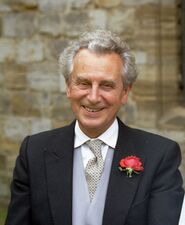
- Maria Andrejczyk (و. 1996)، رامي رمح
- Zalman Gradowski (1910–1944)، كاتب يوميات أوشڤتس-بيركناو السرية
- ماريا كونوپونيكا (1842–1910)، شاعرة وروائية، مؤلفة قصيدة، روتا
- ألفرد كوڤالسكي (1849–1915)، رسام
- Henryk Minkiewicz (1880–1940)، جنرال، قُتل في مذبحة كاتين
- أڤراهام شترن (1907–1942)، زعيم شبه عسكري صهيوني، اسمه الكودي "يائير"، مؤسس منظمة شتيرن
- Edward Szczepanik (1915–2005)، اقتصادي، وآخر [[الحكومة الپولندية في المنفى|رئيس وزراء في المنفى.
- Andrzej Wajda (1926–2016)، مخرج سينمائي، وحائز جائزة أوسكار الفخرية.
- پنحاس ساپير (1906–1975)، وزير مالية إسرائيل
العلاقات الدولية
المدن الشقيقة
سوڤاوكي على توأمة مع:
|
انظر أيضاً
المصادر
- ^ "Local history – Information about the town – Suwałki". Virtual Shtetl. Archived from the original on 2016-10-10. Retrieved 2016-10-10.
- ^ Tadeusz Zdancewicz (2005). "Suwałki – pochodzenie i znaczenie nazwy" [Suwałki – the origin and meaning of the name]. Acta Baltico-Slavica (29): 9–37. ISSN 0065-1044. Archived from the original on 2021-11-20. Retrieved 2021-11-20.
- ^ Maria Wardzyńska, Był rok 1939. Operacja niemieckiej policji bezpieczeństwa w Polsce. Intelligenzaktion, IPN, Warszawa, 2009, p. 234 (in Polish)
- ^ Wardzyńska, p. 234-235
- ^ "Historia Wojskowej Komendy Uzupełnień w Suwałkach". WKUSuwalki.wp.mil.pl. Archived from the original on 2019-05-18. Retrieved 2020-07-03.
- ^ "(Polish Census of 2002) Deklaracje narodowościowe w gminach w 2002 roku". old.stat.gov.pl (in البولندية). Archived from the original on 1 July 2014. Retrieved 30 September 2019.
- ^ (Polish Census of 1931, Białystok Voivodeship) Drugi Powszechny Spis Ludności z dn. 9. XII 1931 r. Województwo białostockie (PDF) (in البولندية). GUS. 1938. p. 31. Archived (PDF) from the original on 2021-08-30. Retrieved 2019-09-30.
- ^ (Polish Census of 1921, Białystok Voivodeship) Skorowidz miejscowości Rzeczypospolitej Polskiej opracowany na podstawie wyników Pierwszego Powszechnego Spisu Ludności z dn. 30 września 1921 r. i innych źródeł urzędowych, Vol. 5, Województwo Białostockie (PDF) (in البولندية). GUS. 1924. p. 80. Archived (PDF) from the original on 2020-11-10. Retrieved 2019-09-30.
- ^ "Russian Empire Census of 1897". demoscope.ru (in الروسية). Archived from the original on 8 August 2020. Retrieved 30 September 2019.
- ^ "Normy klimatyczne 1991-2020 - Portal Klimat IMGW-PiB". Institute of Meteorology and Water Management (in البولندية). Retrieved 2022-02-12.
- ^ "Średnie i sumy miesięczne: Suwałki". meteomodel.pl (in البولندية). 2018-04-06. Retrieved 2022-02-12.
- ^ "Suwałki (12195) - WMO Weather Station". NOAA. Archived from the original on July 19, 2019. Retrieved July 19, 2019.
- ^ "Tarptautinis Bendradarbiavimas" [Druskininkai international cooperation]. Druskininkų savivaldybės administracija (in الليتوانية). 2012-03-22. Archived from the original on 2016-10-08. Retrieved 2013-08-03.
وصلات خارجية
- Official website (in پولندية)
- Suwalki Town Webpage (in پولندية)
- Kurier Suwalski (in پولندية)
- Information and Links on Suwalki[dead link]
- Local media Suwałki (in پولندية)
- Pages using gadget WikiMiniAtlas
- CS1 البولندية-language sources (pl)
- CS1 الروسية-language sources (ru)
- CS1 الليتوانية-language sources (lt)
- Short description is different from Wikidata
- Coordinates on Wikidata
- Articles containing لتوانية-language text
- Pages using Lang-xx templates
- Articles containing يديشية-language text
- Articles containing إنگليزية-language text
- مقالات ذات عبارات بحاجة لمصادر
- Articles with unsourced statements from November 2019
- Articles with unsourced statements from April 2020
- Articles with hatnote templates targeting a nonexistent page
- Articles with پولندية-language sources (pl)
- Articles with dead external links from November 2017
- سوڤاوكي
- مدن وبلدات في ڤويڤودية پودلاسكي
- المقاطعات المدن في پولندا
- تأسيسات القرن 17 في الكومنولث الپولندي-اللتواني
- أماكن مأهولة تأسست في القرن 17
- ڤويڤودية تراكاي
- محافظة سوڤاوكي
- ڤويڤودية بياوستوك
- مواقع الهولوكوست في پولندا
